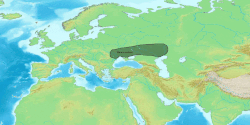| Part of a series on |
| Indo-European topics |
|---|
 |
The Paleo-Balkan languages are a geographical grouping of various Indo-European languages that were spoken in the Balkans and surrounding areas in ancient times. In antiquity, Dacian, Greek, Illyrian, Messapic, Paeonian, Phrygian and Thracian were the Paleo-Balkan languages which were attested in literature. They may have included other unattested languages.
Contents
- Classification
- Subgrouping hypotheses
- Balkanic Indo-European
- See also
- References
- Sources
- Further reading
Paleo-Balkan studies are obscured by the scarce attestation of these languages outside of Ancient Greek and, to a lesser extent, Messapic and Phrygian. Although linguists consider each of them to be a member of the Indo-European family of languages, the internal relationships are still debated. A Palaeo-Balkanic or Balkanic Indo-European branch has been proposed in recent research, comprising the Albanoid or Illyric (Albanian–Messapic), Armenian, and Graeco-Phrygian (Hellenic–Phrygian) subbranches. Regardless of the name, there is no direct evidence to support the location for the hypothetical common ancestor of these languages in the Balkan peninsula itself. [1] Τhe common stage between the Late Proto-Indo-European dialects of Pre-Albanian, Pre-Armenian, and Pre-Greek, is considered to have occurred in the Late Yamnaya period, after the westward migrations of Early Yamnaya across the Pontic–Caspian steppe; also remaining in the western steppe for a prolonged period of time, separated from the Indo-European dialects that later gave rise to the Corded Ware and Bell Beaker cultures in Europe. [2]
Due to the processes of Hellenization, Romanization and Slavicization in the Balkans, the only surviving representatives of the ancient languages of the region are Greek and Albanian. The Albanian language evolved from either Illyrian, often supported for obvious geographic and historical reasons as well as for some fragmentary linguistic evidence, [3] [4] [5] [6] [7] [8] [9] [10] or an unmentioned language that was closely related to Illyrian and Messapic. [11] [12] [13] [14]